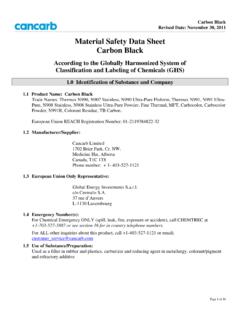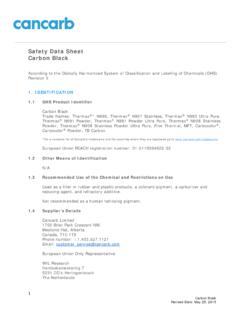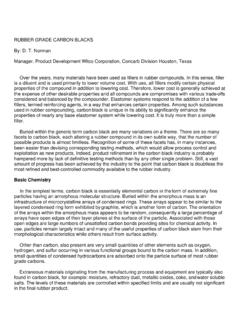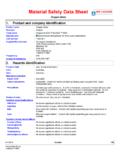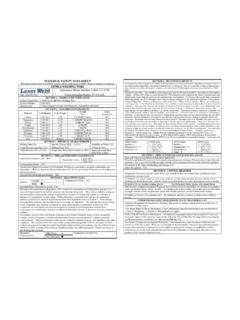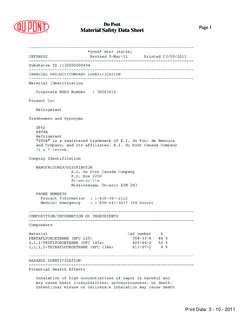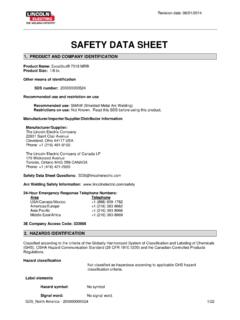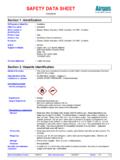Transcription of MATERIAL SAFETY DATA SHEET (ISO 11014-1 / …
1 Revised: 10/16/2012. MATERIAL SAFETY data SHEET . (ISO 11014-1 / ANSI Z / 2001/58/EC). Carbon Black 1. IDENTIFICATION OF THE SUBSTANCE/PREPARATION AND OF THE COMPANY. UNDERTAKING. Product information: Product name (as used on product label): Carbon Black . Grades N-120, N-234, N-326, N-330, LH30, N-339, N-351, N-550, N-650, N-660, N-683, N-762, N-774, IRB #8, Satin Blacks (SBX Grades). Manufacturer/supplier: CONTINENTAL CARBON COMPANY. 16850 PARK ROW. HOUSTON, TX, 77084. Phone number 281-647-3858; (Monday Friday, 7:30 AM to 4 PM). Cellular 713-501-0617. If calling from outside United States use country code (01). Optional emergency CHEMTREC: 1-800-424-9300 (US). number(s): CANUTEC: 613-996-6666 (Canada). Use of substance/preparation Used as filler in rubber products, pigment in polymers and printing inks. REACH Regulation (EC) No. Continental Carbon Registry No. A5736998-02. 1907/2006 REACH Dossier Registration Reference No.
2 01-2119384822-32- 0018, on 29/01/2010. 2. HAZARDS INDENTIFICATION. Emergency Overview [EU: Most Important Hazards]. A black, odorless, insoluble, powder that can burn or smolder at temperatures greater than 572 F. (>300 C). Hazardous products of decomposition can include carbon monoxide, carbon dioxide, and oxides of sulfur. May cause reversible mechanical irritation to the eyes and respiratory tract especially at concentrations above the occupational exposure limit. Some grades of carbon black are sufficiently electrically non-conductive to allow a build-up of static charge during handling. Take measures to prevent the build-up of electrostatic charge. 16850 Park Row, Houston Texas 77084 Page 1 of 14. Revised: 10/16/2012. Regulatory Status EU Not defined as a dangerous substance or preparation according to Council Directive 67/548/EEC and its various amendments and adaptations WHMIS This MATERIAL is classified as D2A under Canadian Worker Hazardous Materials Information System (WHMIS) criteria.
3 OSHA Classified as hazardous. See 29 CFR , Table Z-1. Potential Health Effects Routes of Exposure Inhalation, Eye, Skin Note: Ingestion of carbon black is not considered a likely route of exposure. Acute Effects Temporary discomfort to upper respiratory tract may occur due Acute Inhalation to mechanical irritation when exposures are well above the occupational exposure limit. Acute Ingestion No evidence of adverse effects from available data . Acute eye High dust concentrations may cause mechanical irritation to eye. Acute skin May cause mechanical irritation, soiling, and skin drying. Sensitization No cases of sensitization in humans have been reported. Chronic Effects Inhalation Long-term exposure below the occupational exposure limit of mg/m3 (when measured as total dust) may result in a small loss in one aspect of lung function (FEV1) over a working lifetime. Carcinogenicity IARC listed; Group 2B (possibly carcinogenic to humans).
4 Not listed as a carcinogen by NTP, ACGIH, OSHA or the European Union. There are no known human carcinogenic effects related to the PAH content of carbon blacks. Recent research has shown that the PAH content of carbon blacks is not released in biological fluids and thus not available for biological activity. Potential Environmental Effects No significant environmental hazards are associated with carbon black release to the environment. Carbon black is not soluble in water. See Section 12. 3. COMPOSITION/INFORMATION ON INGREDIENTS. Component(s). Carbon Black, Amorphous (>98%). 16850 Park Row, Houston Texas 77084 Page 2 of 14. Revised: 10/16/2012. Chemical formula: C. CAS number: 1333-86-4. European Inventory of 215-609-9. Existing Chemical Substances (EINECS). number: EU Classification: Not Classified 4. FIRST-AID MEASURES. First aid procedures Inhalation Take affected persons out in fresh air.
5 If necessary., restore normal breathing through standard first aid measures Skin Wash skin with mild soap and water. If symptoms develop, seek medical attention. Eye Rinse eyes thoroughly with large volumes of water keeping eyelid open. If symptoms develop, seek medical attention. Ingestion Do not induce vomiting. If conscious, give several glasses of water, rinse mouth with water. Never give anything by mouth to an unconscious person. Note to physicians Treat symptomatically. 5. FIRE-FIGHTING MEASURES. Flammable Properties It may not be obvious that carbon black is burning unless the MATERIAL is stirred and sparks are apparent. Carbon black that has been on fire should be observed closely for at least 48. hours to ensure no smoldering MATERIAL is present. Carbon blacks containing more than 8% volatile materials may form an explosive dust-air mixture. Manufactured carbon blacks do not exceed 8% volatile materials content (unless otherwise noted by the supplier on package and MSDS).
6 See Section 9, Chemical and Physical Properties. Extinguishing Media Use foam, carbon dioxide (CO2), dry chemical, or water fog. DO NOT USE high pressure water stream as this may spread burning powder (burning powder will float). Protection of Firefighters Wear full protective fire fighting gear (Bunker gear). including self-contained breathing apparatus (SCBA). Special hazards arising from the chemical ( nature of any hazardous combustion products) include carbon monoxide (CO), carbon dioxide (CO2), and oxides of sulfur. NOTE: Wet carbon black produces slippery walking surfaces. 16850 Park Row, Houston Texas 77084 Page 3 of 14. Revised: 10/16/2012. 6. ACCIDENTAL RELEASE MEASURES. Personal Precautions Wear appropriate personal protective equipment and respiratory protection. See section Environmental Precautions Carbon black poses no significant environmental hazards. As a matter of good practice, minimize contamination of sewage water, soil, groundwater, drainage systems, or bodies of water.
7 Methods for Containment Carbon black is not a hazardous substance under the Comprehensive Environmental Response, Compensation and Liability Act (CERCLA, 40 CFR 302), or the Clean Water Act (40 CFR 116), or a hazardous air pollutant under the Clean Air Act Amendments of 1990 (CAAA-90, 40 CFR. 63). Methods for Cleaning Up Small spills should be vacuumed when possible. Dry sweeping is not recommended except with HEPA equipped machinery. A vacuum equipped with HEPA (high efficiency particulate air) filtration is recommended. If necessary, light water spray will reduce dust for dry sweeping but over- wetting may produce very slippery walking surfaces. Large spills may be shoveled into containers. See Section 13. 7. HANDLING AND STORAGE. Handling Avoid dust exposures above the occupational exposure limit. Use local exhaust ventilation to control exposures to below occupational exposure limit.
8 Avoid contact with skin and eyes. If exposed, wash to avoid mechanical irritation and soiling. Dust may cause electrical shorts and is capable of penetrating electrical equipment unless tightly sealed. Ensure equipment is tightly sealed. If hot work (welding, torch cutting, etc.) is required the immediate work area must be cleared of carbon black product and dust. Storage Store in dry place away from ignition sources and strong oxidizers. Before entering closed vessels and confined spaces containing carbon black test for adequate oxygen percent content, flammable gases and potential toxic air contaminants ( , CO, SO2). Follow safe practices when entering confined spaces. 16850 Park Row, Houston Texas 77084 Page 4 of 14. Revised: 10/16/2012. 8. EXPOSURE CONTROLS/PERSONAL PROTECTION. Exposure Limit Values Occupational Exposure Country Limit, mg/m3. Australia TWA. Canada TWA. France TWA.
9 Germany - MAK TWA (Respirable)A. TWA (Inhalable)A. Germany - TRGS 900 TWA (Respirable)B. TWA (Inhalable)C. Italy TWA. Korea TWA. Spain TWA. United Kingdom OES TWA (Inhalable). STEL (10 minutes). REACH Derived No Effect TWA (Inhalable). Level (DNEL). United States - OSHA-PEL TWA. ACGIH-TLV TWA Inhalable (as of 2-1-2011). NIOSH -REL TWA (see Section 11). TWA = 8-hour time-weighted-average, except as noted. MAK = Maximale Arbeitsplatz-Konzentration (maximum workplace concentration) (advisory). TRGS = Technische Regeln fur Gefahrstoffe (regulatory limits). OES =. occupational exposure standard. STEL = short-term exposure limit. OSHA-PEL = Occupational SAFETY and Health Administration - permissible exposure limit. American Conference of Governmental Industrial Hygienists Threshold Limit Value. NIOSH-REL = National Institute of Occupational SAFETY and Health - recommended exposure limit.
10 A. annual average. B applies to all activities except those exempted, consult regulatory agency. C effective April 2004, consult regulatory agency. Engineering Controls Use process enclosures and/or exhaust ventilation to keep airborne dust concentrations below the occupational exposure limit. Personal Protective Equipment Respiratory Approved respirators should be used where airborne concentrations are expected to exceed occupational exposure limits. Hand Protection Wash hands and other exposed skin with mild soap. Use of a barrier cream may help to prevent skin drying. General 16850 Park Row, Houston Texas 77084 Page 5 of 14. Revised: 10/16/2012. protective gloves may be used to protect hands from carbon black soiling. Eye Protection Wear SAFETY glasses or goggles. Skin Protection Wear general protective clothing to minimize skin contact. Work clothes should NOT be taken home and should be washed daily.
